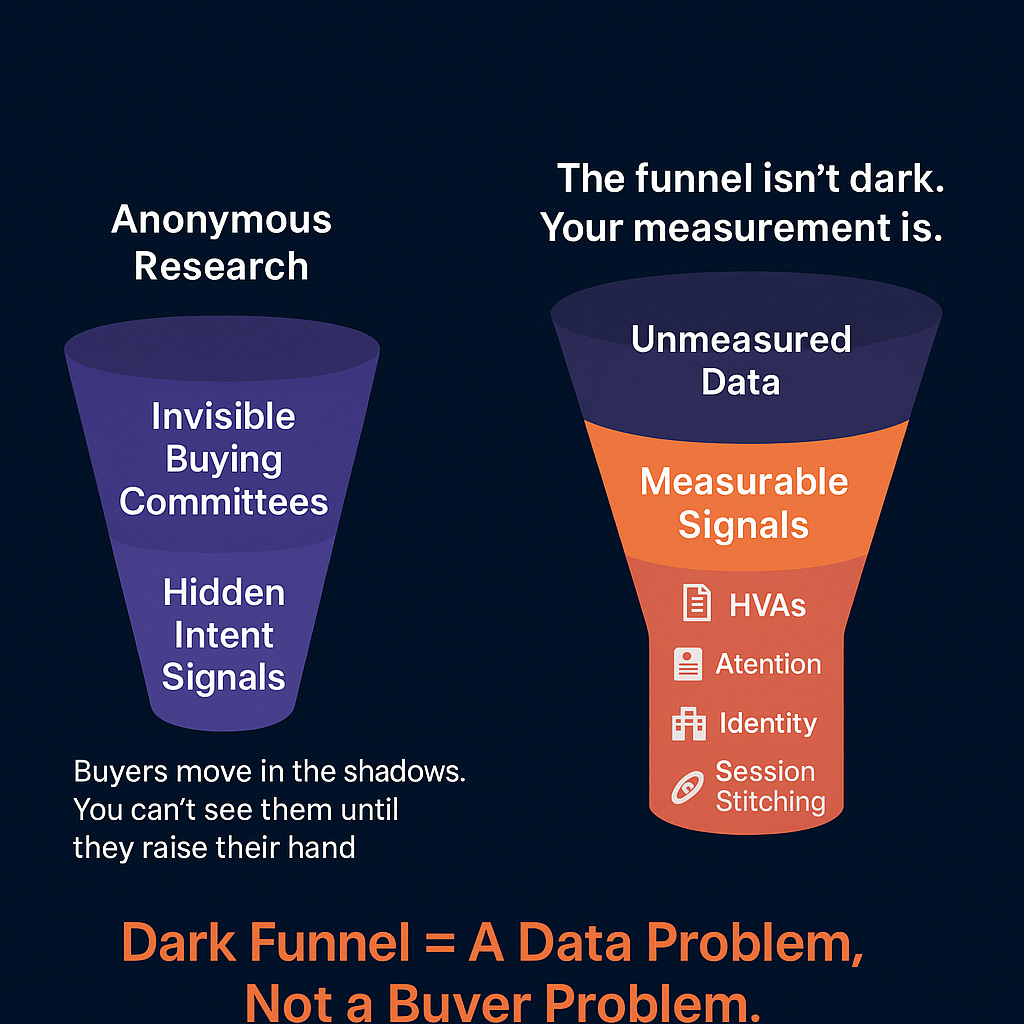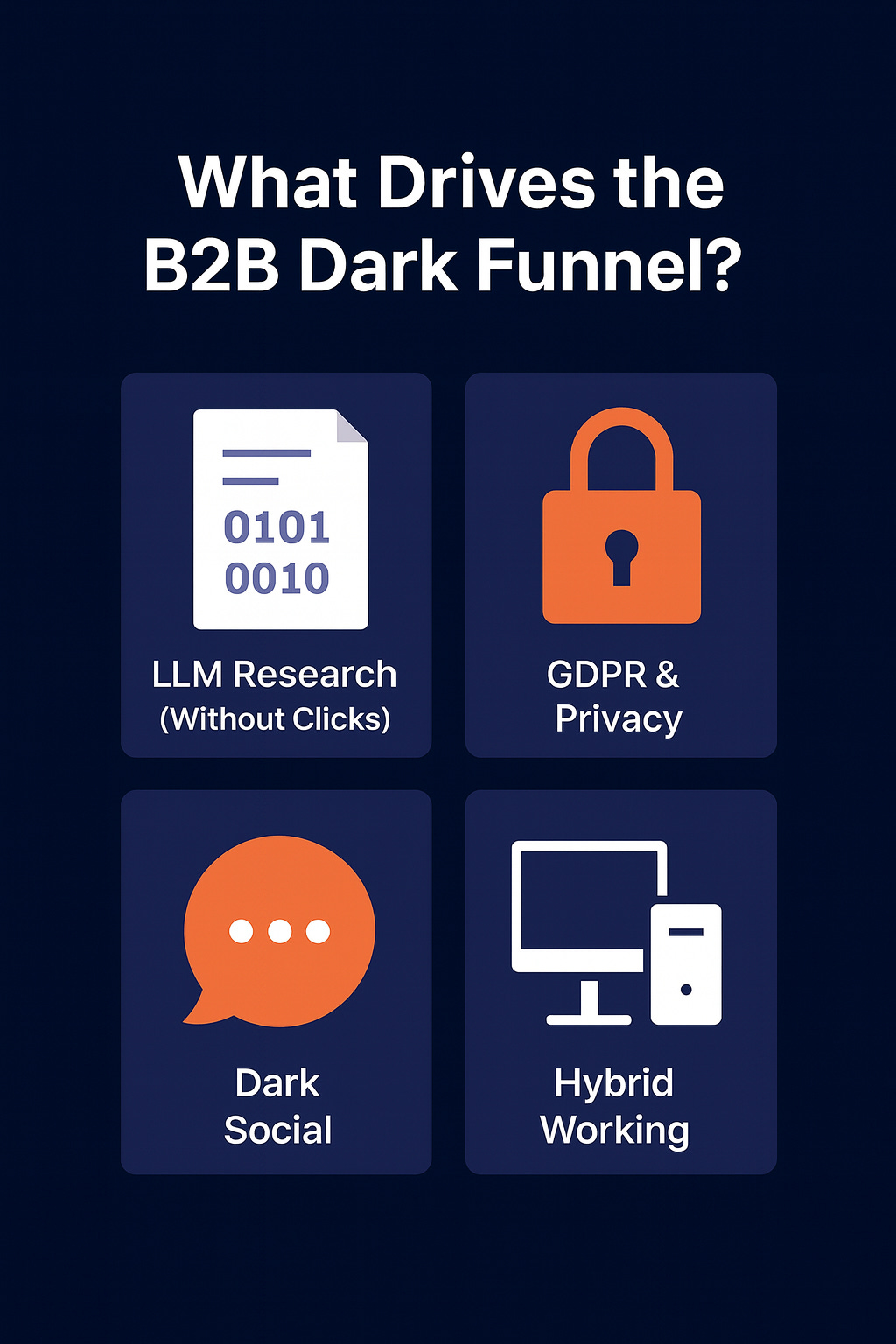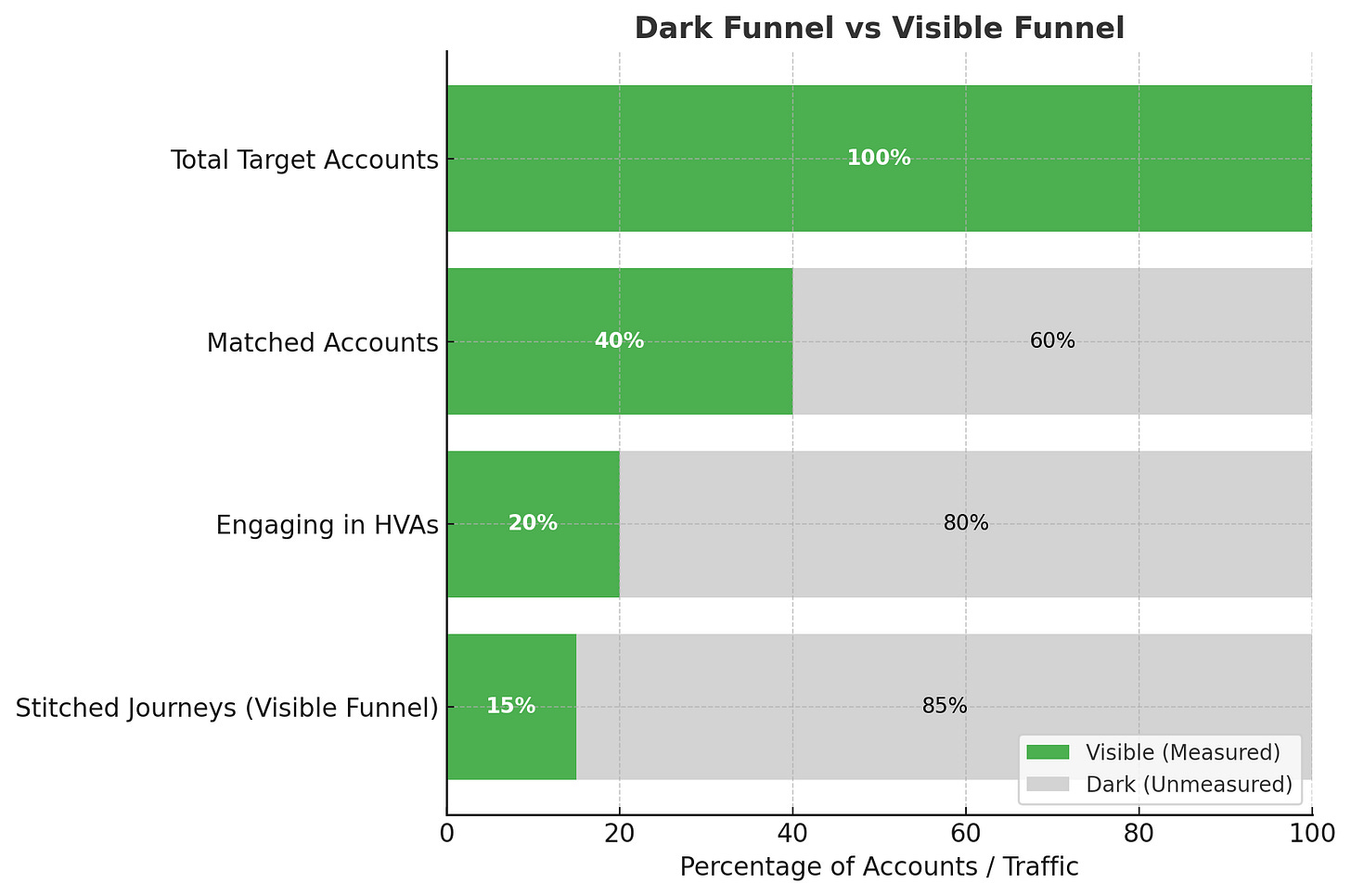The B2B Dark Funnel Is a Data Problem, Not a Buyer Problem
For years, the “dark funnel” has been the most fashionable ghost story in B2B marketing.
Every conference deck has a slide about it. Every vendor pitches a solution to it. And every marketer at some point has nodded gravely when it’s mentioned: “Yes, that’s why we can’t see what our buyers are doing.”
The narrative is seductive: your buyers are out there, moving silently, researching in the shadows, impossible to track until they magically pop up on a demo form. The secret Slacks, WhatsApp groups, socials without referral data and the dreaded LLM all lurk to make our funnel not so much dark, as pitch freaking black.
Here’s the uncomfortable truth: the funnel isn’t dark. Your measurement is.
The Problem With the Dark Funnel Story
Marketers love a simple enemy, and “dark funnel” gives them one. It lets us blame buyers for going invisible instead of confronting the real issue: our data stack is underpowered.
Buyers haven’t suddenly become ghosts. They leave signals everywhere. The real problem is that most marketing teams are blind to those signals because they’re still relying on outdated analytics, click-centric reporting, and weak identity resolution.
When someone says “dark funnel,” what they’re usually describing are data blind spots.
It’s perfectly forgivable in 2025 to have more of those. The world has changed quickly, with cookie based signal loss, silent LLM researching and privacy laws like GDPR making it harder to track site sessions amongst other keys data points.
Four Reasons the Funnel Looks Dark
Weak Identity Resolution
Third-party cookies are gone, and simplistic IP-matching isn’t enough. Many teams see sub-30% match rates. That’s not because buyers disappeared — it’s because the tools in place can’t connect the dots. The buyers moved from office buildings to hybrid, catalysed by the Covid-19 pandemic. 97% of buyers STILL go on the vendor website before they buy, they are just harder to identify then they were when they did so almost exclusively out of their corporate office.Click-Centric Thinking
CTR is still the most-reported metric in B2B media. The irony? A high CTR often correlates with low-quality traffic (students, bots, brand tourists, competitors incentivised to track your messaging, accidental clicks). Meanwhile, the real buying signals — time spent, content explored — get ignored.No Session Stitching
B2B journeys don’t happen in a single neat visit. They sprawl across devices, days, and networks. Without stitching, it looks like dozens of anonymous sessions instead of one account steadily progressing toward a decision.Signal Blindness
The biggest miss: not tracking High Value Actions (HVAs). Things like security page visits, API doc downloads, or time spent on comparison content. There are literally over 100 of these that we advocate for using. These are the strongest indicators of progression — but if you’re not measuring them, you’re literally leaving the lights off in your funnel.
Lighting Up the Funnel
The funnel doesn’t need to stay dark. What actually illuminates it is a modern B2B signal stack:
High Value Actions (HVAs): Defined, trackable actions tied to buyer progression. Footprints of intent which layer up to build a more complete picture of the nurture trail
Attention Metrics: Time on content around ads, attention seconds, video completions. These are proof of real engagement at the ad level, which doesn’t rely on noddy clicks as a barometer of interest. These tell us if our ads and their message is landing
Identity Resolution: IP-to-company mapping, hashed emails, hyper-local and account stitching against an ID graph helps build a more persistent signal mapped to accounts/companies not individuals. The customer in B2B is the parent company not the individual in it, which gives B2B marketers a big advantage over consumer marketing, because the PII consideration is receded. Companies have bigger footprints and more static measurable signals
Session Stitching: Building a continuous journey view across devices and visits.
When these elements are in place, 60–80% of what was previously “untrackable” becomes visible. The result isn’t mystical insight into hidden buyers — it’s simply better measurement of what was always happening.
The real magic starts when you train the worlds best mar-tech AI layers on these powerful signals not on guff like clicks, and let it start actually lifting for metrics that map to revenue and pipeline, not vanity like GA4 session loads
Why This Matters
Treat the dark funnel as unsolvable, and you doom your media to optimie against the wrong signals. You’ll overpay for impressions, chase the wrong clicks, and stay blind to whether your target accounts are actually moving.
Treat it as a data problem, and you open up new levers for growth:
Push HVAs into DSP optimisation (Trade Desk, DV360, Adform).
Score accounts by both fit, intent and behavior.
Detect new buying committee members entering the journey, especially escalation members like compliance and integration teams
Shift spend toward accounts in motion — and cut waste on the ones that aren’t.
This isn’t just about visibility. It’s about margin, precision, and pipeline confidence.
From Theory to Infrastructure
Here’s the kicker: none of this requires exotic technology. The infrastructure already exists. The problem is adoption. Too many teams are stuck with web analytics designed for e-commerce, reporting designed for FMCG, and KPIs that belong in 2012.
That’s why at Unmatched, we’ve built tools to operationalize this shift:
Our High Value Action Generator helps you identify the specific behaviors that matter in your funnel and generate a script to run via Google Tag Manager (GTM) to capture these events
Our B2B Web Analytics Layer captures attention, identity, and session stitching over an account graph so you can measure account journeys properly.
Together, they cut through the “dark funnel” narrative and give you the clarity to act.
👉 Both tools are available inside our Expenses Account Tier membership — because this isn’t about theory. It’s about giving you the measurement backbone to finally see what’s always been there. Our Expense Account holders ($99/year) get access to our bespoke UnMatched Toolkit, which includes all of our tools to enable you to take immediate action based on the information you learn in our content
For Paid Readers 🔒
If you’re on the free tier, you’ve just read 85% of the playbook. But if you want the full thing, here’s what’s waiting behind the upgrade:
The Dark Funnel Visibility Formula — how to calculate your true visibility rate (and compare it to industry benchmarks).
Benchmarks by Sector — what % of traffic is typically lost in SaaS vs. manufacturing vs. services.
HVA-to-Funnel Map — a framework for assigning HVAs to stages and weighting them by attention.
Session Stitching in Practice — a walkthrough showing how the same anonymous “noise” looks once it’s tied into a coherent account journey.
Upgrade to the Expenses Account Tier to unlock the calculator and frameworks, and see exactly how much of your “dark funnel” can be illuminated today.
Keep reading with a 7-day free trial
Subscribe to The B2B Stack to keep reading this post and get 7 days of free access to the full post archives.





